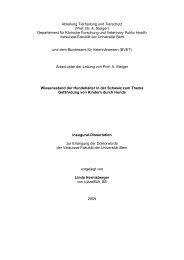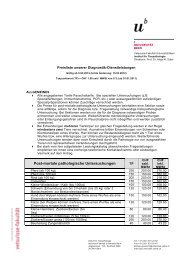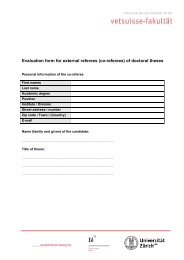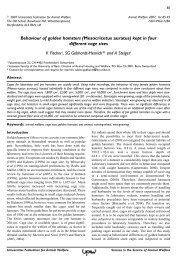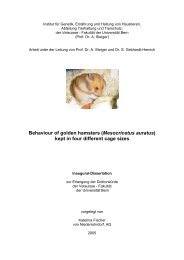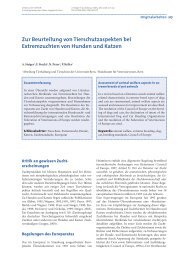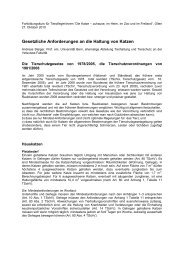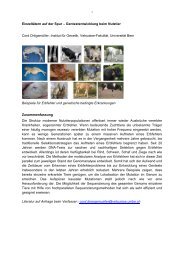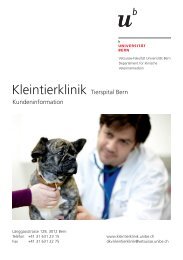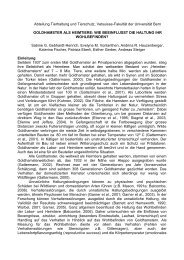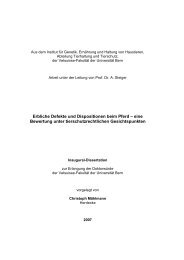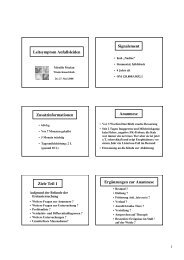Lifespan and Causes of Death in the Irish Wolfhound - Vetsuisse ...
Lifespan and Causes of Death in the Irish Wolfhound - Vetsuisse ...
Lifespan and Causes of Death in the Irish Wolfhound - Vetsuisse ...
Create successful ePaper yourself
Turn your PDF publications into a flip-book with our unique Google optimized e-Paper software.
3.2 Intrahepatic Portosystemic Shunt (PSS)<br />
3.2.1 Description<br />
Portosystemic Shunt <strong>in</strong> <strong>Wolfhound</strong>s is a congenital malformation <strong>of</strong> <strong>the</strong> porto-caval<br />
blood vessels, lead<strong>in</strong>g to gastro-<strong>in</strong>test<strong>in</strong>al <strong>and</strong> neurological symptoms. The condition<br />
is hereditary (simple autosomal recessive; see 3.2.3), but <strong>the</strong> exact mechanism that<br />
causes <strong>the</strong> Ductus venosus to rema<strong>in</strong> open is not known (Meyer, Rothuizen et al.<br />
1995; White, Burton et al. 1998; Ubb<strong>in</strong>k, van de Broek et al. 1998 b; Hunt 2004).<br />
3.2.1.1 Pathophysiology<br />
In healthy dogs, blood rich <strong>in</strong> nutriments <strong>and</strong> ammonia com<strong>in</strong>g from <strong>the</strong> <strong>in</strong>test<strong>in</strong>e<br />
passes through <strong>the</strong> portal ve<strong>in</strong> to <strong>the</strong> liver, where it passes through a capillary system<br />
<strong>and</strong> its many components are chemically modified <strong>and</strong> detoxified before be<strong>in</strong>g<br />
released <strong>in</strong>to <strong>the</strong> ma<strong>in</strong> circulatory system. In <strong>the</strong> foetus, this mechanism is not<br />
necessary, <strong>and</strong> <strong>the</strong> capillary system <strong>of</strong> <strong>the</strong> liver is <strong>the</strong>refore bypassed by <strong>the</strong> Ductus<br />
venosus, which closes soon after birth <strong>in</strong> healthy dogs (Broome, Walsh et al. 2004).<br />
In <strong>Irish</strong> <strong>Wolfhound</strong>s affected with PSS, this vessel fails to occlude after birth, which<br />
causes a leak<strong>in</strong>g <strong>of</strong> toxic metabolic products <strong>in</strong>to <strong>the</strong> bloodstream, lead<strong>in</strong>g to <strong>the</strong><br />
typical symptoms <strong>of</strong> hepatic encephalopathy. Anatomically, <strong>the</strong> persistent Ductus<br />
venosus is located <strong>in</strong>trahepatically <strong>in</strong> <strong>the</strong> left liver division (White, Burton et al. 1998).<br />
3.2.1.2 Symptoms<br />
Patients with PSS <strong>of</strong>ten exhibit non-specific symptoms such as stunted growth,<br />
<strong>in</strong>termittent anorexia, depression, vomit<strong>in</strong>g, PU/PD <strong>and</strong> behavioural changes. Signs<br />
<strong>of</strong> hepatic encephalopathy (ataxia, stupor, head press<strong>in</strong>g, seizures etc.) are <strong>of</strong>ten<br />
<strong>in</strong>termittent <strong>and</strong> usually worsen after feed<strong>in</strong>g, especially when a high prote<strong>in</strong> diet is<br />
used (Watson <strong>and</strong> Herrtage 1998; Fossum <strong>and</strong> Hedlund 2002). Affected dogs<br />
typically develop symptoms before one year <strong>of</strong> age (Broome, Walsh et al. 2004).<br />
3.2.1.3 Diagnosis<br />
Most affected animals are microhepatic on X-rays (Fossum <strong>and</strong> Hedlund 2002), <strong>and</strong><br />
it is usually possible to demonstrate an <strong>in</strong>trahepatic PSS through ultrasonography<br />
(Suter <strong>and</strong> Niem<strong>and</strong> 2001 a). Sc<strong>in</strong>tigraphy follow<strong>in</strong>g rectal adm<strong>in</strong>istration <strong>of</strong> TcO 4 is<br />
ano<strong>the</strong>r possible way <strong>of</strong> diagnosis – <strong>in</strong> case <strong>of</strong> a shunt, <strong>the</strong> marker reaches <strong>the</strong> heart<br />
before or at <strong>the</strong> same time it reaches <strong>the</strong> liver (Bernhardt, Westh<strong>of</strong>f et al. 1996).<br />
Haematological signs may <strong>in</strong>clude normochromic microcytosis, mild nonregenerative<br />
anaemia, target cell formation or poikilocytosis. Plasma album<strong>in</strong> <strong>and</strong> BUN may be<br />
lowered due to reduced liver function. ALAT, ASAT <strong>and</strong> AP may be slightly raised,<br />
while serum bilirub<strong>in</strong> is usually normal (Fossum <strong>and</strong> Hedlund 2002). Urate crystals<br />
may be found <strong>in</strong> <strong>the</strong> ur<strong>in</strong>e <strong>of</strong> up to 50% <strong>of</strong> affected dogs (Suter <strong>and</strong> Niem<strong>and</strong> 2001 a).<br />
<strong>Wolfhound</strong> puppies can be screened for <strong>the</strong> presence <strong>of</strong> a PSS from about six weeks<br />
<strong>of</strong> age through measur<strong>in</strong>g postpr<strong>and</strong>ial serum bile acid levels between 90 to 120<br />
m<strong>in</strong>utes after feed<strong>in</strong>g. A deliberately low threshold value <strong>of</strong> 30 μmol per litre is set <strong>in</strong><br />
15



